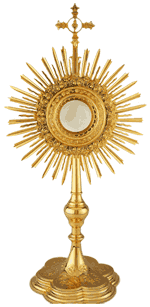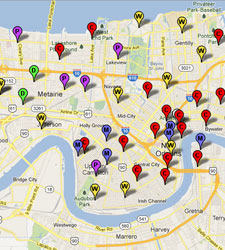The tradition of a St. Joseph Day altar came to New Orleans from the Italian people of Sicily. During the middle ages, Sicily faced a severe drought, and the people were reduced to eating fava beans, which were usually given to the animals. They prayed for the intercession of St. Joseph, and their prayers were answered: the rains came! In thanksgiving, the people of Sicily developed a tradition to decorate the St. Joseph Altar on the right side of most of their churches (or to make a small private altar at home) with flowers, fruit, candles, wine, fava beans, specially prepared cakes, breads, fish and cookies. Since the Feast of Joseph (March 19) almost always occurs during Lent, no meat is allowed on the altar.
The custom of preparing an altar as a symbol of devotion to St. Joseph is rooted in the thanksgiving for his intercession years ago, but it also points to thanksgiving for a personal favor granted, for healing of the sick, or for success in business. Further, it’s an opportunity for the prosperous to share with those who are less fortunate.
As you will see in our church next Friday, the altar is in the shape of a cross, and has three tiers, to represent the Holy Trinity. Breads and cakes on the altar take the form of common Catholic symbols. There is the Monstrance which holds the Holy Eucharist during Adoration (every Tuesday from 4:45pm – 5:45pm in St Stephen, and Thursday from 7:00am – 8:00am in St Henry). There is a Chalice which holds the Precious Blood. And you can also note the Holy Cross, the dove (Holy Spirit), lamb (Jesus as the Lamb of God), hearts (Sacred Heart of Jesus, Immaculate Heart of Mary) and fish (“I will make you fishers of men”). A crown of thorns and a ladder refer to the crucifixion of Christ, and the palms testify to His victory over sin and death.
Besides the bread images, there are wine bottles representing the miracle of Cana, and whole fish representing the miracle of the loaves and the fishes. Other items specific to Sicily include grapes, olives and figs reminiscent of the orchards and vineyards one finds there. Another food is the pignolatti: fried pastry balls joined together by caramel in the shape of a pine cone representing the pine cones Jesus played with as a child.
Probably the best known of the customs associated with the St. Joseph’s Day altar is the fava bean. Since it thrived while other crops failed, it became the sustaining food of farmers and their families. The dried bean is commonly called a “lucky bean,” and legend has it that the person who carries a “lucky bean” will never be without coins.
The food to be served on Thursday will be wonderful Italian food, including pasta with red gravy, eggplant, artichokes, fried vegetables, fried fish and wonderful salads. Additionally, foods will be served with a garnish of breadcrumbs to represent saw dust – since St. Joseph was a carpenter. Last year more than 2000 plates were served over the course of the afternoon!




